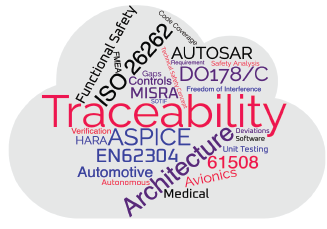Trace. Track. Automate your Compliance
Traceability is a key concept in functional safety. Every safety item should be able to be traced to something. There should be no “orphan” untraced elements. This means that every requirement should be able to trace to its realization in the design and its verification or validation. Doing this type of tracing analysis is difficult because it is current a manual process which can lead to errors.
Traci eliminates that manual error-prone process. Traci is a traceability matrix used to identify gaps in the design and verification of requirements as required by standards such as ISO 26262, DO-178B/C, IEC 62304, IEC 61508, and others.
The Traci traceability engine comprises a unique DSM multi-domain visualization of gaps, impact analysis, metrics, and reporting. It will also automatically produce a report that demonstrates consistency and completeness for compliance. The impact analysis will show the impact of changes in customer requirements down to the code and tests that are used to validate the requirements.
Trace through the implemented architecture
Traci uniquely uses analysis of the software architecture and its implementation to show how requirements are interrelated, and shows the change impact across all compliance information for every change in the software.
Gaps between the Technical Safety Concept and Stakeholder requirements to the software requirements and the implemented software architecture are visible as empty cells in the traceability matrix, with violations of Must-Have rules shown with red triangles.




